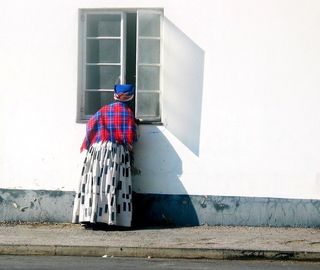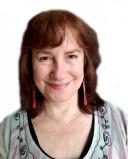Flow
(Not So Small) Lessons About Writing and Life
Fictional marriages can teach you a lot.
Posted January 10, 2018

Ashley Hay, who lives in Brisbane, Australia, has written three novels that take on complex psychological and family interactions in nuanced and original ways. They include The Body in the Clouds, The Railwayman's Wife, and her latest, A Hundred Small Lessons. She has also written four narrative nonfiction books, as well as stories, essays, and journalistic pieces.
I hope you enjoy her responses to my questions as much as I did.
Q&A with Ashley Hay
Q: I loved The Railwayman's Wife (I'm the blogger who blurbed it as "a literary and literate gem."). I couldn't imagine you would pull it off as well with your novel that's just come out in the United States, A Hundred Small Lessons. Yet you did. How did you get into the mind of an elderly woman struggling with mortality and loss?
Thanks for that lovely line about The Railwayman’s Wife, Susan, and for your lovely comments about A Hundred Small Lessons. I’m not sure I can answer that question, although I’m thrilled you think this new book does succeed. I spent a lot of time imagining and writing Elsie as I worked my way into this book, and I probably drew on all sorts of people I know and have known over the years, as well as imagining how I might feel if I was in her place.
The Railwayman’s Wife and A Hundred Small Lessons were each built around a distinct seminal moment, a kind of emotional instant to which I kept returning. In Railwayman’s Wife, it was the idea of Ani having to work so close to the sound of the thing that had killed her husband (the trains). In this new book, it was the idea of an elderly person leaving their house without knowing they were going for the last time. They were my touchstones, I guess.
Q: Do you go through a lot of revising to create such flawless stories? Do you have any particular methods you use once your first draft is complete?
I’m so pleased that they read flawlessly to you. A Hundred Small Lessons had a very different process to The Railwayman’s Wife. I had to write myself into it and discover what it was and how it was going to work much more than I’d had to with the previous novel. I started AHSL with that first chapter about Lucy and Elsie – it was a standalone short story – and realised about a year later that I was really interested in these two women; that I wanted to know more about who they were and what was happening for them.
I’m not actually sure how many drafts it took (there were a lot …), but I can remember the sense of it clarifying and coming into focus as I went, with occasional magical-feeling moments when I realised how something in one woman’s era reflected or intersected with something in the other woman’s timeline. It felt like a process of accretion and a process of exploration with spots of something more alchemical as well.
Q: I could relate so well to your characters, including the old house itself, as I live in a house that was built in 1928. Do you have any experience like that, or are you simply amazingly intuitive, imaginative, and psychologically oriented?
Susan, you say the loveliest things! My parents built a house more than fifty years ago and still live there; my husband’s parents also lived in just one house for decades, so we both had childhoods that were very solidly located in one place, and adulthoods spent returning to those places a few times each year. I’ve lived in different cities, different countries, all over the place, but I’ve always had a very clear sense of the difference between a house and home.
After we’d lived in Brisbane for a couple of years, we bought a house here, and we bought it from an elderly lady who was moving into an aged-care facility. I think the experience of coming into her space, and how I felt about both my parents’ home and my in-laws’ home, all fed into the different experiences I wanted to give to the very mobile Lucy and the very anchored Elsie.
Q: Motherhood can certainly present an evolving quandary for a modern woman. I found that to be true even way back in the 1970s. There are no easy, final answers, are there?
One of the things I was interested in exploring in the book was that while the experience of motherhood has certainly changed across different generations of women, it’s not a uniform experience in any era. It will also depend on the personality and the desires and the interests of each individual woman, and on all the other contexts and opportunities and relationships of their particular world. We all do it differently, whenever and however we do it, because we bring all our own experiences and expectations to it, and we do it in combination with our specific partners, our own families, perhaps the other jobs we keep having to do.
Before my son was born, I’d read pieces by different creative women about the challenges that motherhood presented to them, and many of them felt quite hamstrung and frustrated by the way it impacted their creative practice. For me, motherhood was a creative thing in and of itself: I couldn’t have written this novel without it, in the first place, and I often found it both enriching and very galvanising.
Q: What is your creative process, more or less? Does it differ much from fiction, nonfiction, and your essays? Do you enter a flow state while writing?
I’m always interested in the architecture or the topography of a piece, whether it’s fiction, non-fiction or essays, so in that way the process by which I try to write anything is perhaps the same. But it’s also different for each piece, depending on what I arrive with, or what I need to discover as I go along.
I love the days when I do end up in the bliss of a flow state; they’re the days I dream of. But by the same token I love the days that are about solving a piece of a puzzle, or unravelling a mess I’ve made, or working out how something connects with something else. I even love the days when I’m stumping along and not really sure what I’m doing. It’s a privilege to be able to do this kind of work, and I’m grateful that I enjoy its different pieces and parts.
Q: When you shift from the point of view of one generation to the next, do you write those scenes in that order, or do you stick with one voice, and then divide them later?
I tend to have a different process for each book. In this one, I was a long way into the drafting process before I realised that I needed more of Elderly Elsie’s voice, so I did write most of those bits more as a block. But the others I wrote as they came – for Lucy, and the younger Elsie, and for the two husbands, Ben and Clem. Then I had to work out how they all slotted together.
For more about Ashley Hay and her work, see her site.
(c) 2018 by Susan K. Perry, author of the novel Kylie's Heel


